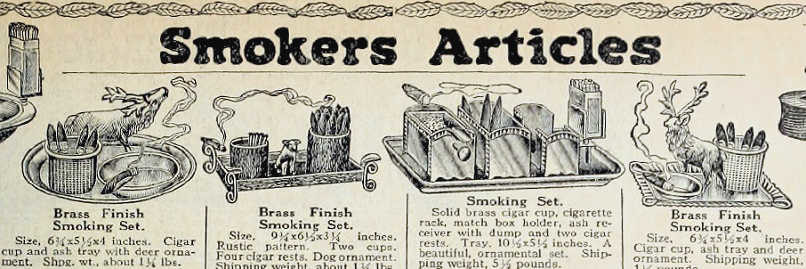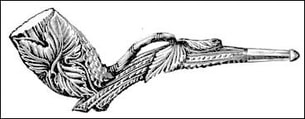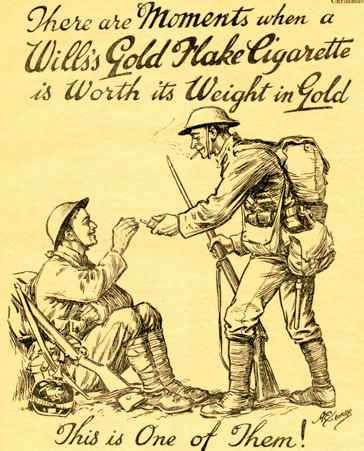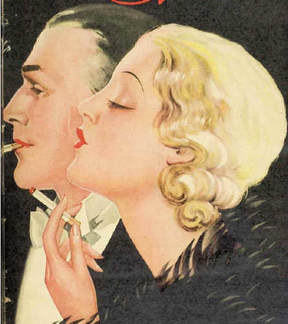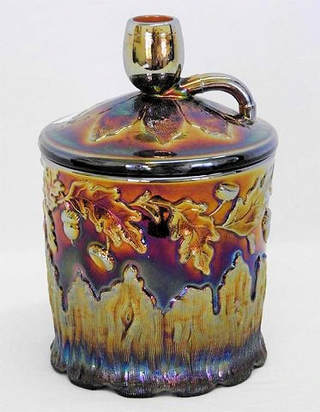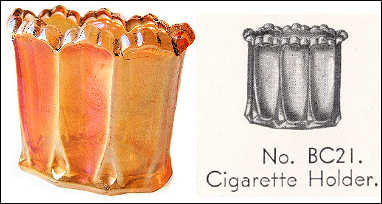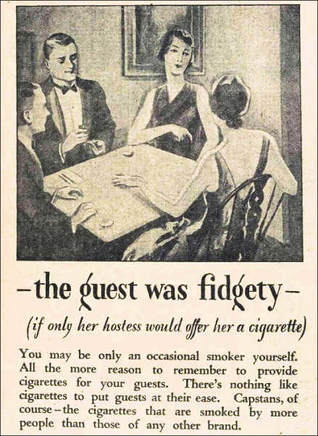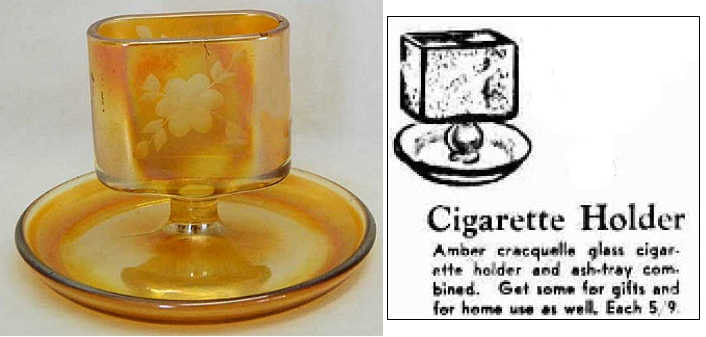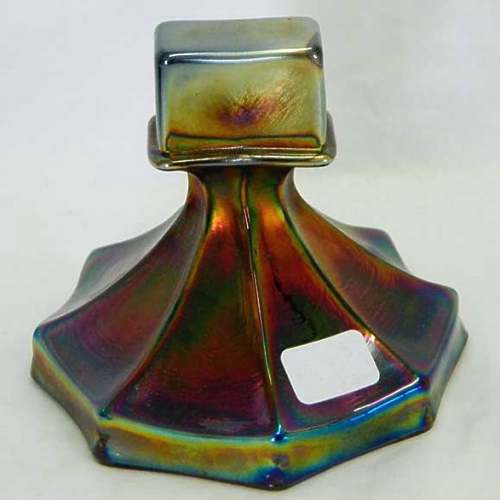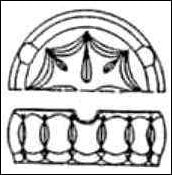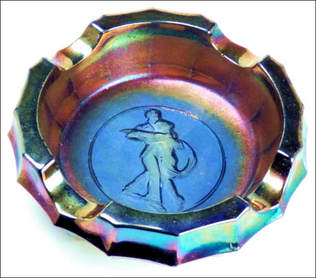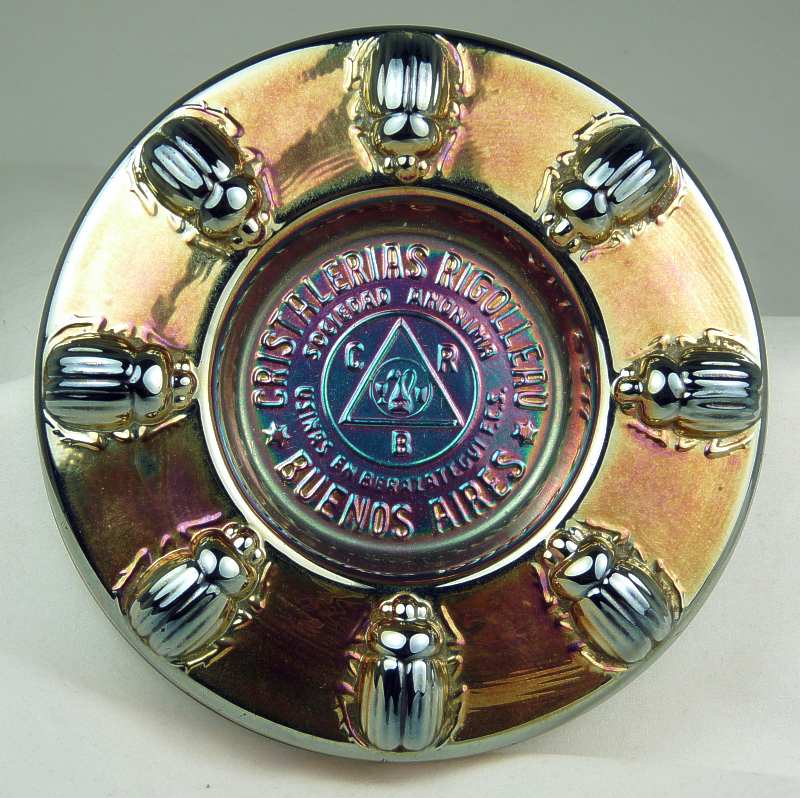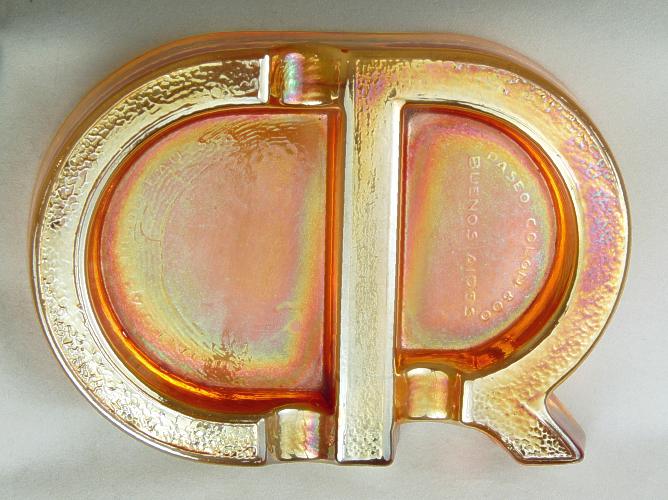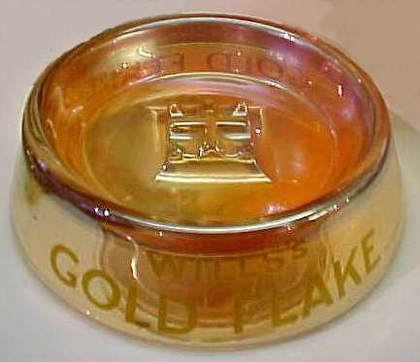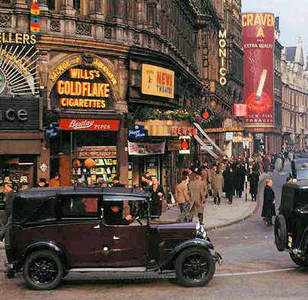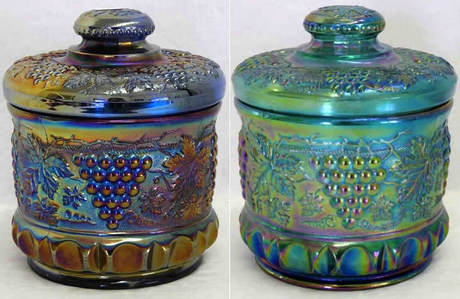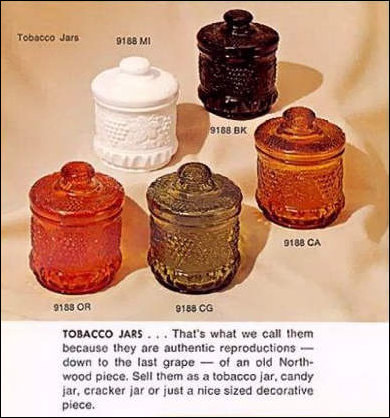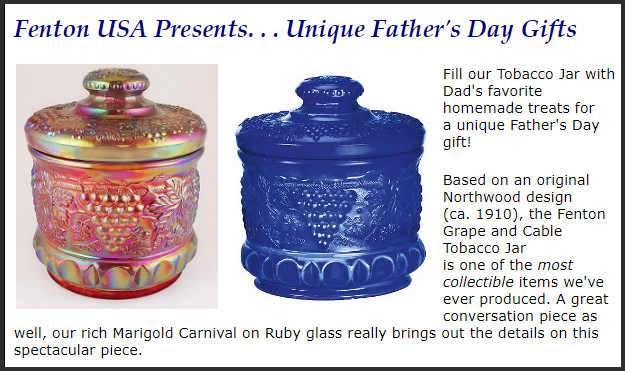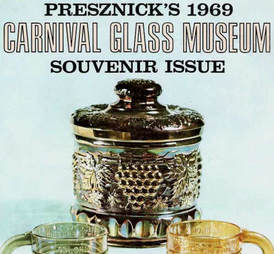NetworK ezine Issue 41. October 2018
Totally devoted to Carnival Glass
|
Smoke Gets in Your Eyes
Carnival Glass was made for everyday folk – it was inexpensive, and it was meant to be used as well as admired. The shapes in which it was made reflect the lifestyles of people over the last century. What we now call Tobacciana - collecable items related to tobacco products and cigarettes - is especially fascinating in what it reveals about our society's changed attitude to smoking and health. As seen through the eyes of Carnival Glass collectors, it becomes even more intriguing … |
|
Let’s start along tobacco road with this Millersburg Pipe Humidor from c. 1910, shown on the right. It is a splendidly showy item: it would have looked perfect alongside this rustic pipe that Sears were selling some years earlier.
Tobacco began to be used in the 1500s, while pipes, cigars, snuff and even early cigarettes, were in use from the 1600s. By the mid-1800s, cigarettes (as we know them) and safety matches had been invented. Fast forward to c. 1910, and Carnival pipe humidors like the Millersburg one here, were of course, used for storing tobacco. Inside the lid there are three glass prongs to hold a moist sponge that would keep the stored tobacco in perfect condition.
However, Carnival Tobacciana didn’t really take off until a decade or so later, when the popularity of the cigarette boomed. |
An amethyst Millersburg Pipe Humidor.
Courtesy Seeck Auctions. Although WWI had seen an upsurge in cigarette smoking among the troops, it wasn’t until tobacco advertisers began to focus on the female population during the 1920s, that the advent of Carnival Glass items designed for smokers really took off. On into the 1930s and smoking became glamorous, as women were targeted by the advertisers. |
Cigarette Holders
Cigarette holders were small containers that held a few cigarettes, and were generally intended to be used as part of an elegant table setting.
Cigarette holders were small containers that held a few cigarettes, and were generally intended to be used as part of an elegant table setting.
|
Seldom seen, below is a Ring-Around cigarette holder.
It was made by Zabkowice of Poland in the 1930s. Known only in marigold, this exquisite little beauty stands just 2¼” high and is 2½” wide across its front side. It’s narrow, measuring just over 1” at its widest point, and it would probably have held around six upright cigarettes. This rare item has been recorded recently (and given the name Eight Flutes) - it was originslly thought to have been a toothpick holder or salt. However, the catalogue evidence shows clearly that the intended use was a cigarette holder, and importantly, that the pattern is one previously recorded and known as Ring-Around. This 1930s ad on the right appeared in an Australian women’s magazine: it explained perfectly why the cigarette holder would have been used. It was for cigarettes to be elegantly offered to guests at the table. “Provide cigarettes for your guests” to put them at their ease. |
|
Below on the left is a marigold Etched Flowers and Leaves cigarette holder that is cleverly teamed up with an ashtray as its base. It is a Fenton piece (#556), and it was also made without the floral etching (photo Seeck Auctions).
Other similar items were made, although they are sometimes called match holders. On the right is one such example - it is an Imperial Penny Match Holder in purple - another rarity.
|
Ashtrays
Ashtrays are known in a variety of designs; some are exceedingly rare while others are found more easily. An unusual one is this massive item - we previously referred to this as Regina, made by Walther of Germany (see our “Art of Carnival Glass” 2004).
Our subsequent research has shown this to be a Ring-Around ashtray from Zabkowice of Poland (catalogue image on the right).
Ashtrays are known in a variety of designs; some are exceedingly rare while others are found more easily. An unusual one is this massive item - we previously referred to this as Regina, made by Walther of Germany (see our “Art of Carnival Glass” 2004).
Our subsequent research has shown this to be a Ring-Around ashtray from Zabkowice of Poland (catalogue image on the right).
The Ring-Around ashtray is a huge and heavy piece of glass – and such a contrast to the diminutive little Ring-Around cigarette holder shown earlier! The ashtray is 7” across and weighs almost 3 pounds! The base of the Ring-Around ashtray is ground very smooth and polished, and features an incised pattern.
More Scarce and Unusual Ashrays
From Finland, this very rare Tanssi ashtray in blue was made by Karhula, featuring a couple dancing the tango. Unusual? You might expect tango dancers to be from South America … not the chilly Nordic countries. The Tanssi story is fascinating!
Of course, there are also some amazing and scarce ashtrays from South America, such as the Beetle ashtray (known in amber, as shown, marigold, blue and purple) and the CR ashtray (known in marigold, as shown, green and blue). Both were made by Cristalerias Rigolleau.
These three unusual items are covered in detail elsewhere on our website - they might just surprise you! Here are the links:
Tanssi Ashtray: The Story Behind the Glass
Beetle Ashtray: Collectors Facts
CR Ashtray: Collectors Facts
Tanssi Ashtray: The Story Behind the Glass
Beetle Ashtray: Collectors Facts
CR Ashtray: Collectors Facts
And here’s one that perhaps isn’t quite as glamorous, but it has secrets of its own, and a story to tell - the Wills’s Gold Flake Ashtray.
On the side of this 5" marigold ashtray are the words WILLS’s GOLD FLAKE. Wills was a popular tobacco and cigarette brand in the UK, and the ashtray is marked underneath with PATENT No. 827277, which was registered in the UK in 1938. Despite knowing that the registration was lodged by T.H. Lawley (a patent agent), we do not know which company actually made the glass itself.
The lettering on the glass is silk screen printed, and there is a code on the piece that probably refers to it.
|
Back on Tobacco Road
On the left of the two Grape and Cable pieces pictured here is a Classic, old Carnival Grape and Cable humidor (in blue) that was made by Northwood. The one on the far right is a Contemporary Carnival version which was made in aqua by Fenton. Both photos courtesy of Seeck Auctions. The Fenton version was introduced in the late 1960s as an "authentic reproduction", and was called a “Tobacco Jar”. Here is a contemporary Fenton ad. One very significant feature serves to distinguish the old from the new – the new Fenton version does not have the three prongs inside the lid (they held a dampened sponge which kept the tobacco moist and fresh) that is found on the old Northwood version. |
|
It appears that the new mould was made by Fenton to faithfully reproduce the old Northwood humidor. Fenton themselves say in their ad that it “was inspired by a similar item produced more than 100 years ago by Harry Northwood in Wheeling, W. Va.” Shown below is another Fenton ad where they promoted it for filling with "homemade treats". Mindful perhaps of a trend away from tobacco? |
|
The Fenton Grape and Cable tobacco jar assumed an importance that could not have been predicted, when Rose Presznick asked Fenton to produce it in Carnival Glass as a money-making souvenir venture for her Museum. Presznick wrote that she wanted it “fully marked with the trademark ‘Fenton’ and we would want our Museum wording to be cut into the glass rather than raised. This would enhance its value to the collector and this item could in no way be misused in the future since the lid mould was already minus the old three prongs used to hold the sponge.”
The Presznick Grape and Cable souvenir was made in purple Carnival, and on its base has the moulded lettering: PRESZNICK’S CARNIVAL GLASS MUSEUM LODI, OHIO 1969 There is also the oval Fenton cartouche in the centre and inside the lid are the letters RP and JP for Rose and Joe Presznick. From then on, Fenton strived to mark all their Carnival with the Fenton trademark. Read about Rose Presznick's Carnival Glass Museum, part of our "Blast From The Past" series of articles. |
Privacy and the use of your information: we only use your name and email address to send you your FREE Carnival Glass NetworK ezine. We will not share your name or email address with anyone else, or use it for any other purpose. You can change your mind about receiving your NetworK ezine at any time by clicking the unsubscribe link at the foot of every issue, or by emailing us at [email protected]
Join us on Facebook
We invite you and your friends to join us all on NetworK's fast growing and very active Facebook Group (link is below), and if you have missed any of the previous issues of NetworK and NetworK Specials, they are all here: Back Issues.
We invite you and your friends to join us all on NetworK's fast growing and very active Facebook Group (link is below), and if you have missed any of the previous issues of NetworK and NetworK Specials, they are all here: Back Issues.

